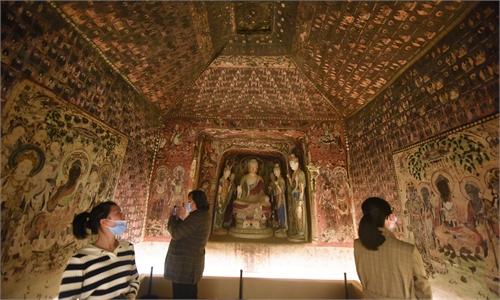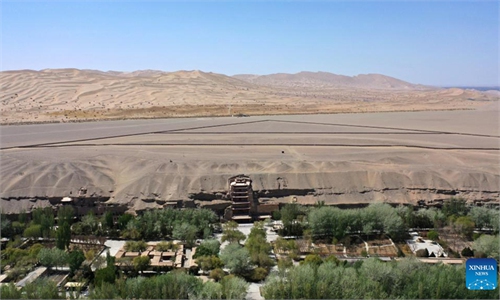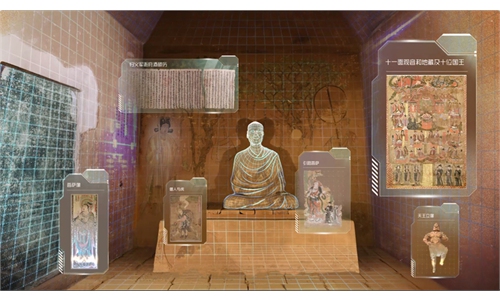ARTS / ART
Young artist goes viral by recreating Dunhuang frescoes at Mogao Grottoes
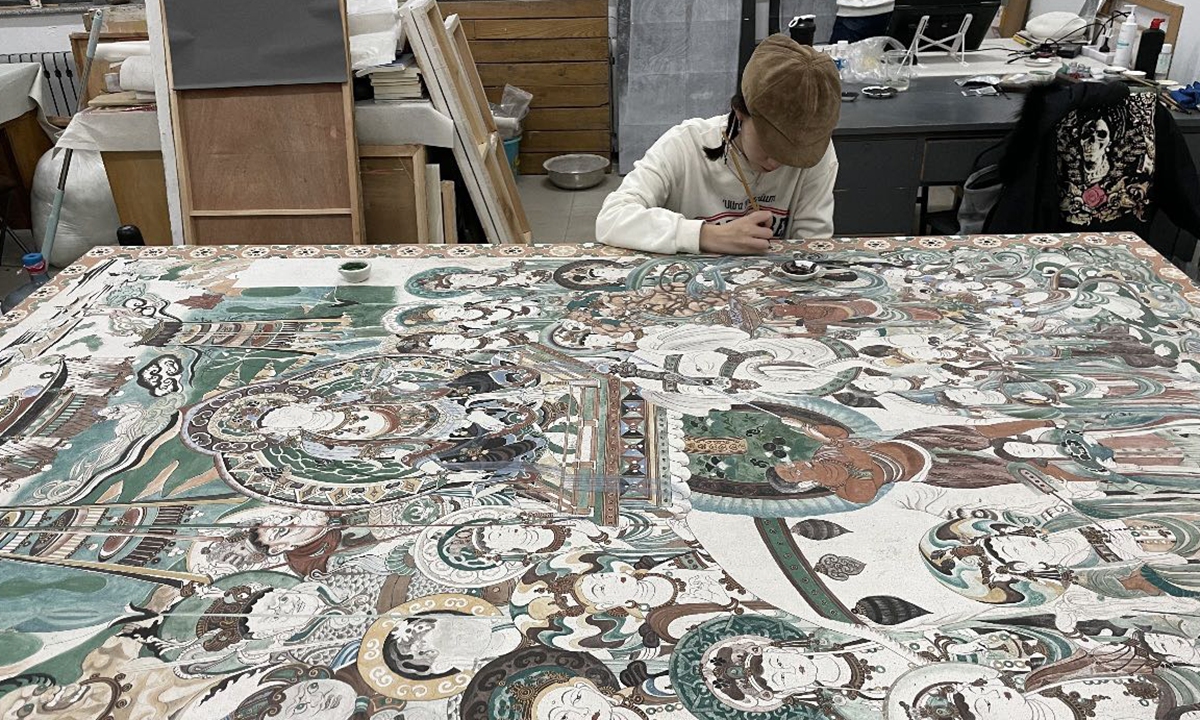
Photo: Courtesy of Qin Yueyu
Containing 735 caves full of Buddhist art, the Mogao Grottoes attracts more than 1 million visitors every year to Dunhuang, Northwest China's Gansu Province. Among the many beautiful works of art in these caves set in the eastern cliffs of the Mingsha Mountains, the numerous paintings on the walls of the caves have captured the imagination of people around the world. Considering this fascination, it is no wonder that a group of young artists have recently gone viral by transforming these large murals into portable works of art.
Qin Yueyu, a Gen Z postgraduate student majoring in art restoration from East China's Shandong Province, has recently made a name for herself after she posted her graduation work on Chinese social media. The work faithfully recreates the well-known classic Tang Dynasty (618-907) fresco The Samantabhadra Story in Dunhuang.
"To recreate this fresco, we needed to create a mud base layer on a wooden board to imitate the texture of the walls in the cave," Qin explained to the Global Times.
"By observing the damaged murals inside the caves, we saw that the mixture of mud and plant fibers created a rich visual texture, so on the drawing board we used materials such as wheat straw and grass fibers."
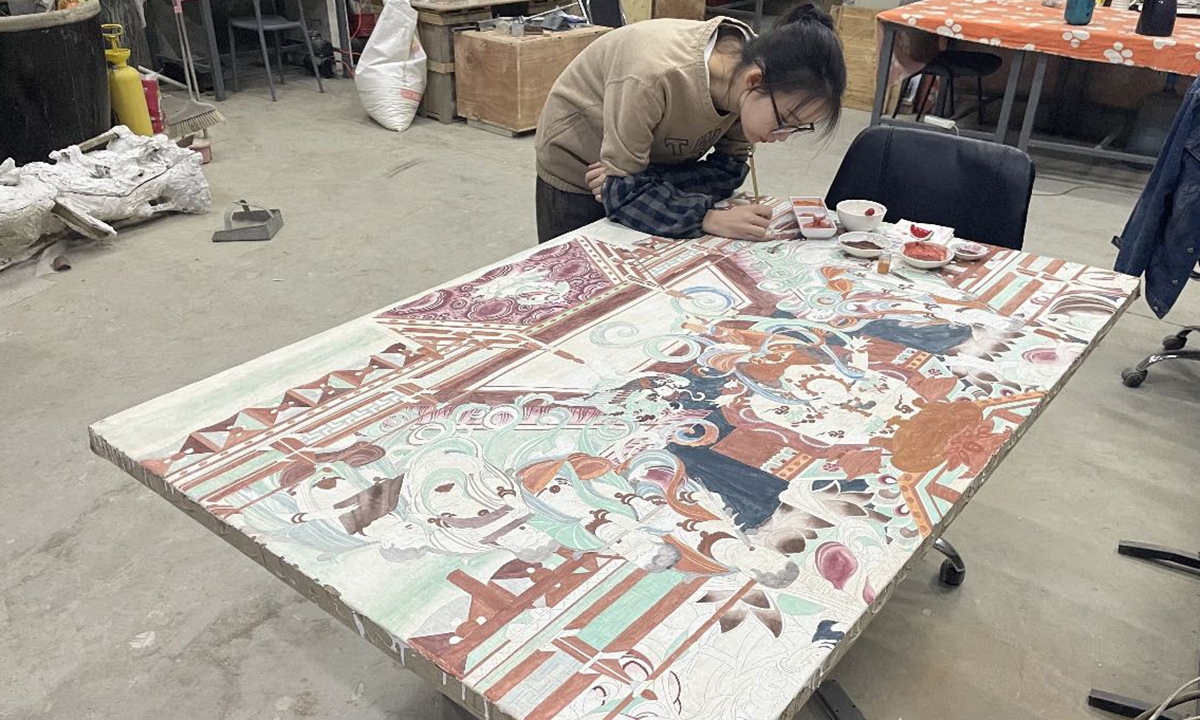
Photo: Courtesy of Qin Yueyu
In the painting, the Bodhisattva Samantabhadra sits on the back of a white elephant as other servant deities surround her. In the background is Mount Emei in Sichuan Province and on the mountain waterfalls, temples and pavilions can be scattered along the landscape.
"The figure of Samantabhadra on a white elephant is an ethnic symbol. Some of the figures inside the painting also wear special face makeup that is the origin worn in traditional Chinese opera," added Qin, who spent half a year recreating the painting.
"Traditional frescoes are fixed on cave walls or temples, but we used the knowledge learned in our major to turn the fresco into a portable work or art. I plan to continue down this path," Qin said.
Filling in the blanks
Unlike the watercolor landscape paintings that are commonly considered to represent Chinese paintings during the Ming (1368-1644) and Qing (1644-1911) dynasties, this art form from India, with its Buddhist background and bold colors, brought a different style to Chinese art that could be enjoyed by later generations.
The Mogao Grottoes are the heart of what is known as Dunhuang studies. For Dunhuang scholars, the role of these Dunhuang frescoes in Chinese art history, with their strong colors, dense lines and complex and rich content, not only fills in a blank for paintings prior to the Tang Dynasty, but also rewrites China's art history, showing that China was not limited to watercolor or ink paintings, but also had paintings with rich religious backgrounds.
"The Dunhuang frescoes show an integration of the painting aesthetics of China and the western regions, since they were originally inspired by Buddhist beliefs from the culture of the western regions. This made the aesthetics - the characters formation, applied colors and visual presentation - very different from the paintings that originated in China," Guan Linhui, an art expert specializing in Xizang Thangka paintings, told the Global Times.
"When it comes to the subject, traditional Chinese paintings often use delicate or freehand strokes to depict people from everyday life.But due to the spiritual nature of Buddhist belief, Dunhuang paintings, especially those depicting spiritual figures, have more liberal line strokes, more dense and pure colors such as blacks, reds and greens that emphasize the colorful nature of the painting. This to me is a way to express their diverse imagination," Guan said.
Obsessed young protectors
With advances in digitalization technology, preservation of the artworks at the grottoes have reached some major milestones. In addition to helping forward research, these digitization efforts are also being used to give more people access to the grottoes online, thus increasing their popularity, especially among young people.
Data from the Dunhuang Academy in 2018 shows that the number of tourists to the grottoes has increased by an average 23 percent annually over the past several years, among whom the majority of visitors were young people such as students.
"But if young people only have a little understanding of Buddhist culture, they won't be able to appreciate Dunhuang culture, instead they will only see dazzling images in front of them," Du Juan, deputy director of the Dunhuang Academy, explained.
To educate more young people about Dunhuang culture, the Dunhuang Academy in 2014 decided to bring the caves online through a digitization project. To this end, they formed a young Dunhuang research team to take full responsibility of presenting the inside of the caves.
From data collection to post-production, including adding audio explanations, picture displays and small videos, it can take several years to digitize the caves.
For people like Qin, they feel it their responsibility and obligation to reinterpret ancient culture like that found at the grottoes.
"By using new media platforms to rejuvenate ancient culture, more people can get to know the beauty of this glorious Chinese art hidden deep in the mountains that has been dormant for a long time," Qin added.
